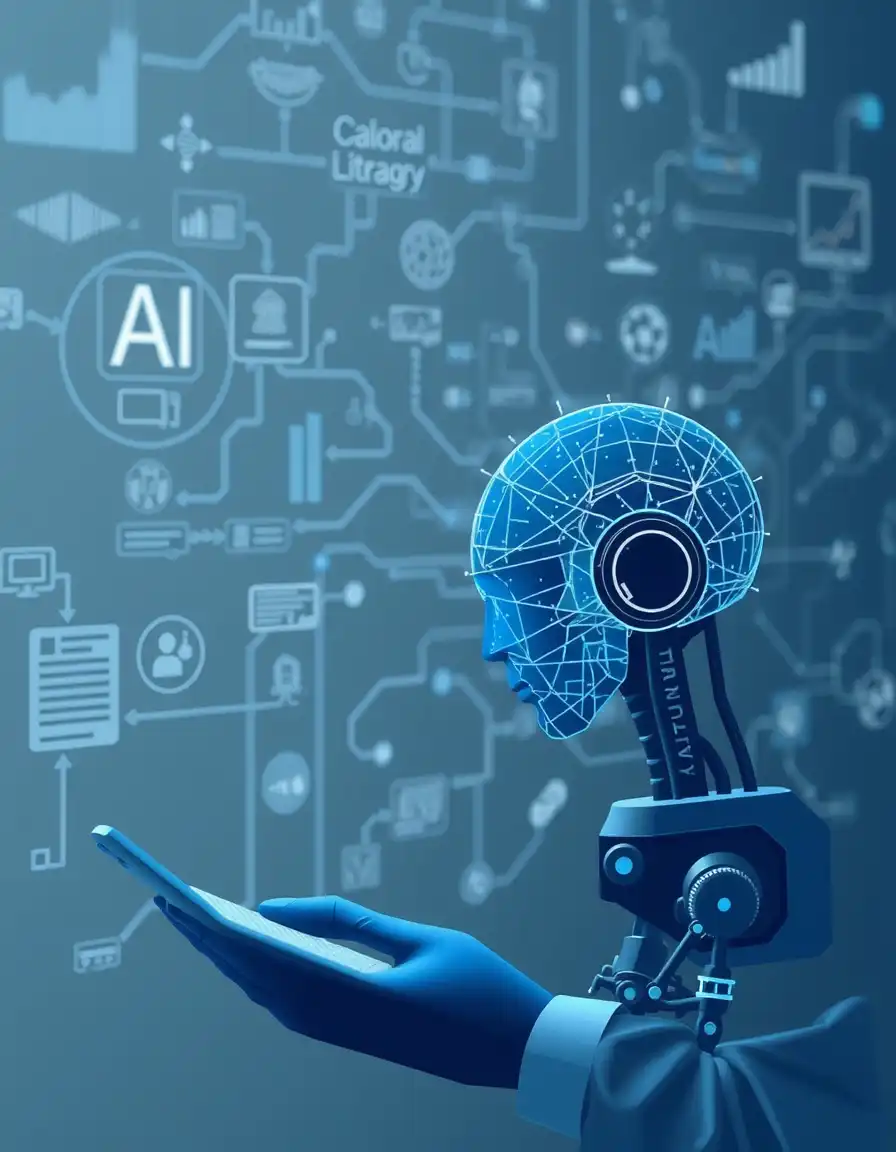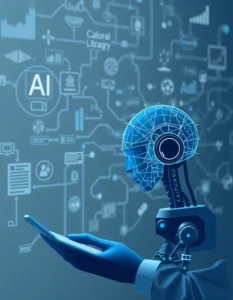AI Literacy in 2025: Key Trends and Challenges Ahead
September 13, 2025 | Gudstory Org AI News
Thank you for reading this post, don't forget to subscribe!Imagine a world where understanding artificial intelligence becomes as fundamental as reading or basic math. That world isn’t some distant future—it’s happening right now. As we progress through 2025, AI literacy has transformed from a tech industry buzzword into an essential life skill that governments, schools, and businesses are scrambling to teach their people.
But this rapid shift brings both unprecedented opportunities and alarming challenges. While AI promises to democratize knowledge and revolutionize how we work, it’s also creating new forms of inequality and ethical dilemmas that society is still learning to navigate.
Beyond Chatbots: What AI Literacy Really Means
Forget the misconception that AI literacy is simply about knowing how to use ChatGPT. Today’s definition is far more comprehensive and nuanced. True AI literacy encompasses understanding what these powerful tools can and cannot accomplish, mastering the art of effective prompting, and developing the critical thinking skills to evaluate AI-generated content.
Perhaps most importantly, it includes the ethical judgment to recognize when AI might be biased, when privacy is at risk, and when human expertise should take precedence over machine recommendations. This holistic approach helps educators and employers create concrete learning objectives instead of vague technology adoption goals.
Five Game-Changing Trends Reshaping Education and Work
1. AI Enters Every Classroom
Gone are the days when artificial intelligence was confined to computer science electives. Schools worldwide are weaving AI concepts into science classes, language arts curricula, and even civics lessons. International organizations have developed age-appropriate frameworks that introduce students to both AI’s capabilities and limitations from an early age.
2. Regulations Force Corporate Training
European Union regulations now explicitly require organizations to ensure their staff achieve adequate AI literacy levels. This regulatory pressure has triggered a massive wave of corporate investment in certified training programs and internal governance systems, fundamentally changing how businesses approach employee development.
3. The Great Workforce Reskilling Rush
Companies are desperately seeking both AI specialists and “AI-aware” professionals across all departments—from product managers to HR staff to frontline workers. While governments and corporations are launching numerous upskilling initiatives, training capacity still falls short of demand in many regions, creating a bottleneck in the transition to an AI-integrated workforce.
4. Assessment Revolution in Schools
The rise of generative AI has forced educators to completely rethink how they evaluate student learning. Instead of simply trying to prevent AI use, innovative teachers are redesigning assessments around in-class synthesis, oral examinations, and project-based learning that demonstrates genuine competence rather than tool restriction.
5. Corporate-Led Literacy Initiatives Scale Up
Private companies and non-profit organizations are launching ambitious programs aimed at certifying millions in basic AI skills. While these cross-sector efforts create accessible learning resources, they also raise important questions about who controls the curriculum and which commercial tools become normalized in education.
The Dark Side of the AI Literacy Boom
Despite the excitement surrounding AI education, significant challenges threaten to undermine these efforts:
The New Digital Divide
Access to AI literacy isn’t equally distributed. Disparities in device availability, internet connectivity, teacher training, and language-appropriate resources are creating what experts call an “AI divide.” Without targeted intervention, these tools risk widening existing inequalities rather than closing them.
Teacher Training Crisis
Educators are expected to lead this transformation, but many lack the time, incentives, or training to teach AI responsibly. Creating effective professional development programs and ready-to-use lesson plans requires substantial investment that many educational systems are struggling to provide.
The Measurement Problem
How do you actually measure AI literacy? Current assessment approaches vary wildly—some focus on technical proficiency, others on critical thinking skills. The absence of standardized, meaningful metrics makes it nearly impossible to compare programs or track genuine progress.
Corporate Curriculum Concerns
While company-created training programs can scale quickly, heavy reliance on vendor-developed materials risks creating bias toward specific commercial tools or proprietary workflows. Educational institutions need transparent, open curricula that serve student needs rather than corporate interests.
The Trust and Safety Challenge
As people increasingly rely on AI for everything from research summaries to medical information, teaching verification skills becomes critically important. Students and workers need to learn when AI might be hallucinating, biased, or simply wrong—and when human expertise is irreplaceable.
A Roadmap for Success: What Leaders Must Do Now
For Government Officials and Policymakers
Smart investment is key. Rather than implementing blanket programs, leaders should fund targeted teacher training and establish regional digital hubs that serve underserved communities with hardware, connectivity, and culturally relevant content.
Setting clear, age-appropriate national learning standards while requiring publicly auditable curricula can help avoid vendor lock-in and ensure educational quality.
For Educators and School Leaders
The future of assessment lies in measuring applied reasoning and critical judgment through presentations, portfolios, and in-class tasks rather than traditional take-home assignments.
Successful programs use modular lesson plans that combine hands-on tool experience with ethics discussions, building complexity gradually across grade levels.
For Business Leaders and HR Professionals
A two-track approach works best: specialized technical training for AI professionals alongside broad “AI fluency” programs for general staff covering prompting, verification, and privacy considerations. Role-based competency frameworks ensure training connects to actual job responsibilities.
For Technology Companies and Curriculum Developers
Transparency builds trust. Learning tools should provide clear explanations of model limitations, data sources, and bias mitigation efforts. Prioritizing multilingual resources and offline-capable materials ensures broader accessibility.
Quick Wins That Work Today
Some strategies are showing immediate results:
Microcredentials offer short, skills-focused, verifiable badges that employers recognize and value.
Classroom AI contracts create clear, student-teacher collaborative guidelines for acceptable tool use and proper citation practices.
Open-source lesson plan repositories allow smaller schools to quickly adopt high-quality educational materials without reinventing the wheel.
The Lifelong Learning Imperative
Leading AI researchers emphasize that meta-skills—the ability to learn and adapt as tools evolve—matter more than mastering any specific platform. This means AI literacy programs must be designed as ongoing, iterative learning experiences that are modular, updateable, and closely tied to real-world applications.
Educational systems and employers that embrace this continuous learning mindset will be better positioned to harness AI as a democratizing force rather than a source of new inequality.
The Choice Before Us
As 2025 unfolds, AI literacy has moved from optional to essential. The potential to amplify human creativity, expand job opportunities, and improve public services is enormous—but realizing these benefits requires coordinated action across smart policy, educator-focused investment, robust assessment methods, and public transparency.
The alternative is a world where powerful tools deepen existing divides and people surrender critical judgment to machines. The encouraging news is that practical, scalable solutions exist today. The challenge for this decade is making those solutions equitable, measurable, and sustainable for everyone.
The AI literacy revolution is here. The question isn’t whether we’ll adapt—it’s whether we’ll do so in a way that lifts everyone up or leaves people behind.


